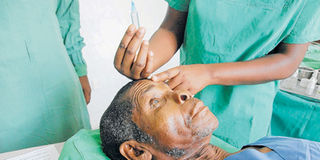How glaucoma is stealing your sight

A patient being screened for potential glaucoma case in one of the health facilities.PHOTO|COURTESY
What you need to know:
However, Johnson, an electronics engineer based in Dar es Salaam, unlike his grand father he has faced problems with is eyes since childhood.
Dar es Salaam. When Robert Johnson, 50, was told by doctors that he was on the verge of losing his sight due to ‘eye pressure and glaucoma,” nostalgic memories of his late grandfather struggling with a similar ailment flooded his mind.
However, Johnson, an electronics engineer based in Dar es Salaam, unlike his grand father he has faced problems with is eyes since childhood.
“Since I was child, my vision has not been good. I have worn glasses all these years. Little did I realise that I would end up undergoing surgery,’’ he recounts.
When he was recently diagnosed with the same condition that had afflicted his late grandpa, it dawned on him that he could have inherited the disease, but he wasn’t sure.
“I couldn’t have thought about this before. That an eye problem can be inherited? Not before!” said Johnson as he narrated his ordeal ahead of the World Glaucoma Day.
Johnson is not alone, many people in Tanzania and elsewhere are not aware of glaucoma. This, according to experts, makes the people with the disease end up at the hospital when it’s already too late to deal with complications.
. The visual damage is irreversible. This has led to glaucoma being described as the “sneak thief of sight.”
How Johnson noticed the problem
“One day, I woke up early in the morning, preparing to go to work,’’ he says, as he curtain-raises his story; a tale that meant he could go the proverbial extra mile to seek for advanced medical care.
“That day, I couldn’t go to work as I had planned. I had severe headache. I was in great pain. My wife couldn’t stand seeing me in that situation. She took me to hospital,”Johnson narrate.
Luckily too, he is enrolled with one of the health insurance schemes in the country.
“When we arrived at the International Eye Hospital in the city, doctors checked me and said I was suffering from glaucoma,’’ says Johnson.
He adds: There and then, I was put on plan for surgery, after which, I have been going to the hospital for further check-ups and follow up treatment.
In Tanzania, glaucoma can be diagnosed and treated at health facilities such as the Comprehensive Community-based Rehabilitation in Tanzania (CCBRT), Muhimbili National Hospital (MNH), the Kilimanjaro Christian Medical Centre (KCMC) and some private hospitals.
Answer to Johnson’s puzzling question
Throughout the treatment, Johnson took time to understand the disease, and, doctors didn’t disappoint him.
“I got to know that glaucoma can actually be inherited. Now I know, I could have inherited the problem from my grandfather.”
Glaucoma, which Johnson is now grappling with are a group of diseases that damage the optic nerve. Genetic factors, according to various studies play a key role in all major forms of the disease.
When glaucoma is in its early stages, it is not easy for the patient to discover.
“It often begins affecting a patient without obvious symptoms,’’ says Prof Ugurcan Keski a specialist in eye diseases based in Dar es Salaam.
“Even the slightest loss of vision may go unnoticed, especially in the type known as primary open-angle glaucoma. In this type, many people do not get medical help until permanent damage to the eye has occurred,’’ he explains.
Ms Naomi Joshua, 55, a retired officer and resident of Tabata says she started seeing darkness.
At one pointshe was seeing spetrum of colours.
“I could wear glasses but that did not help. It even got worse,” says Naomi who later sought treatment other facilities in Dar es Salaam. However, by the time she got diagnosed with glaucoma and eventually undergoing surgery, she had suffered some complications.
Why late diagnosis
Last year, researchers in Tanzania found out that a large proportion of patients with this type of glaucoma, the primary open-angle type, were already visually impaired or blind when they reported to a tertiary hospital.
The study aimed at investigating the patients reporting and the treatment decisions taken for patients with this type of glaucoma at referral hospitals in East Africa.
The researchers, from the Comprehensive Community Based Rehabilitation in Tanzania (CCBRT), said further training to the clinic staff in making early surgical referral and investigation of gender barriers was required.
In another type, known as normal tension glaucoma, the eye pressure could be normal but the optic nerve can still undergo damage due to reduced blood supply to the optic nerve,.
But also, there is another type of glaucoma that is common among people in African. It’s the angle closure glaucoma
“It usually requires emergency interventions. If not, the patient may immediately lose eyesight completely,’’ he points out.
For decades, studies have addressed the challenges faced by health workers in diagnosing glaucoma in Tanzania specifically, and Africa in general.
Over 11 years ago, a report in the Community Eye Health Journal, titled: How to manage a patient with glaucoma in Africa, said, “Finding the patient while there is still some useful vision to save is one of the major challenges in the management of glaucoma in Africa.”
The report further states that: Population-based glaucoma screening is not advocated because there is no proper screening test and it is impractical.
The report, however, suggests that there are many active community outreach programmes targeting those with treatable blindness and visual impairment, such as cataract, which can also be used to refer glaucoma patients earlier . A 2015 study further highlights the challenge people in Tanzania face in finding access to healthcare, pointing out the gaps in terms of awareness.
Titled, ‘Glaucoma awareness and access to healthcare: perceptions among glaucoma patients in Tanzania’ the study states that enhancing the understanding of glaucoma may improve access.
It was published in the Pub Med Journal.
The researchers found that this initiative can trigger earlier reporting of the problem to the health facility, informing those at risk and improving adherence to treatment.
Signs of glaucoma
Patients with glaucoma may have headache and pain in areas above the eyebrows.
Those with the type known as angle-closure glaucoma have severe pain with headache and vomiting.
Also the onset of the disease may be at 40 years of age, but according to experts, it doesn’t mean that it cannot occur in younger people.
Studies have shown that patients who are on long-term treatment with medications known as corticosteroids have a higher risk of developing several conditions, including glaucoma. The risk is even greater with eye drops containing corticosteroids.
This, according to experts, happens in patients who use medications such as steroids for a long time and without the supervision of medical professionals.




